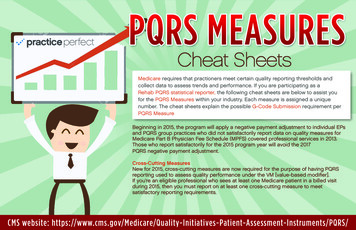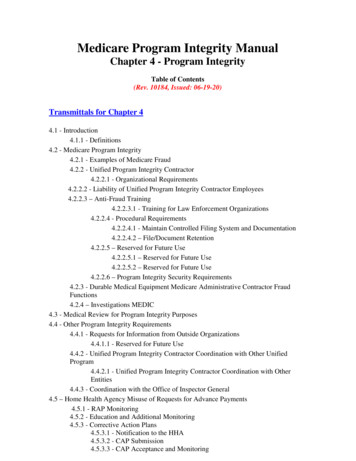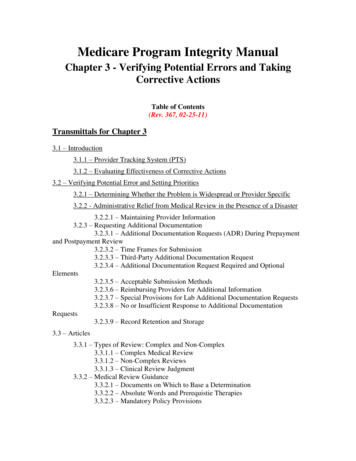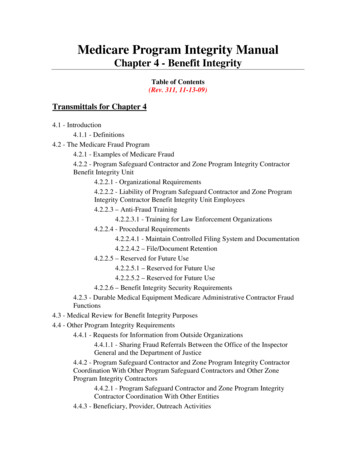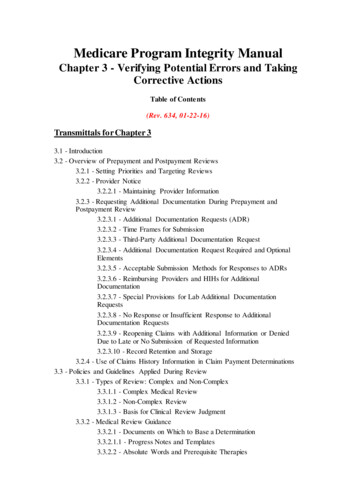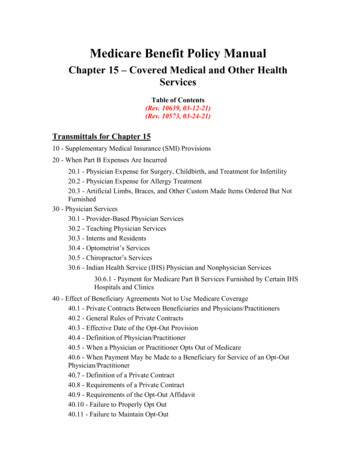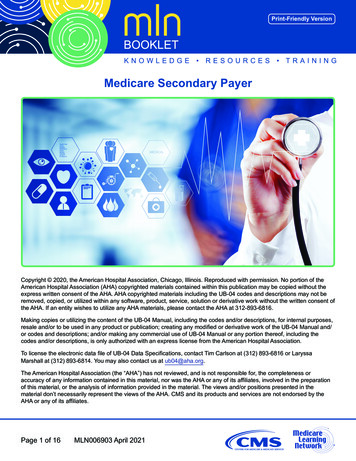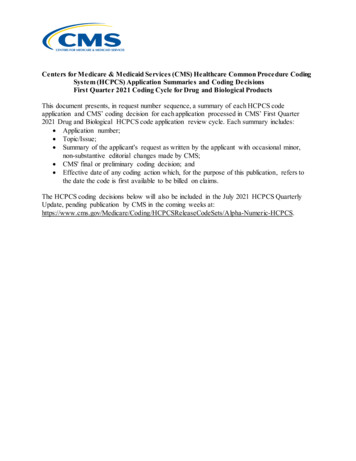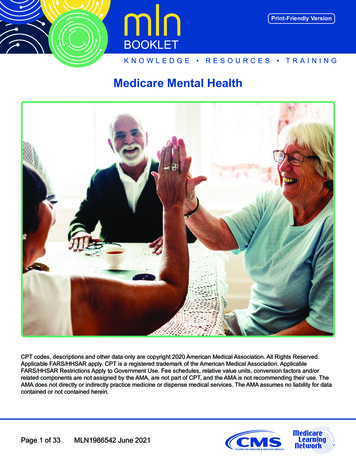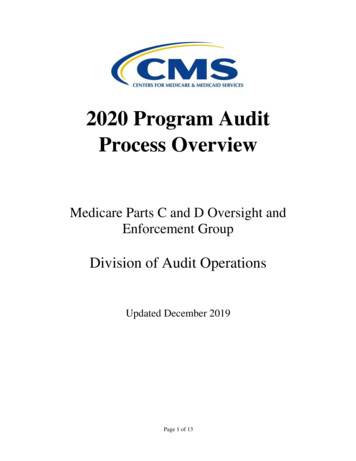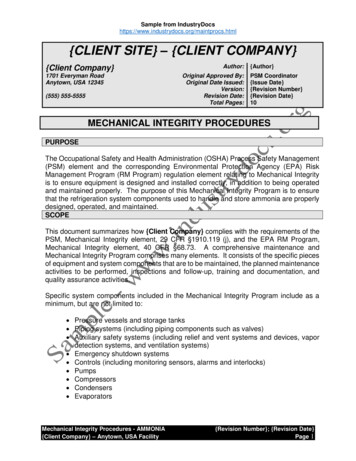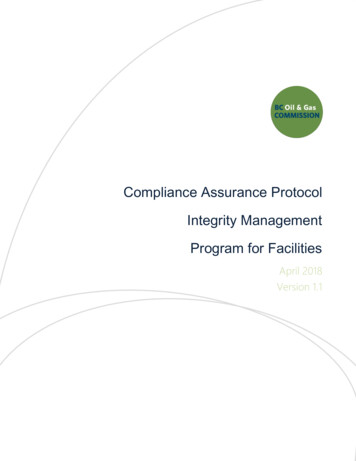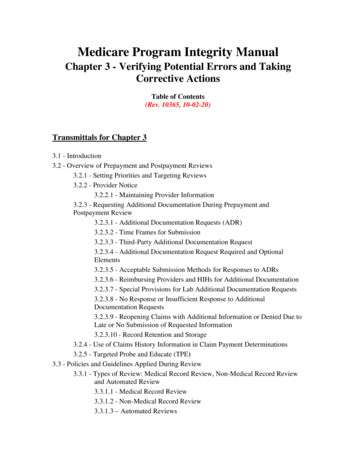
Transcription
Medicare Program Integrity ManualChapter 3 - Verifying Potential Errors and TakingCorrective ActionsTable of Contents(Rev. 10365, 10-02-20)Transmittals for Chapter 33.1 - Introduction3.2 - Overview of Prepayment and Postpayment Reviews3.2.1 - Setting Priorities and Targeting Reviews3.2.2 - Provider Notice3.2.2.1 - Maintaining Provider Information3.2.3 - Requesting Additional Documentation During Prepayment andPostpayment Review3.2.3.1 - Additional Documentation Requests (ADR)3.2.3.2 - Time Frames for Submission3.2.3.3 - Third-Party Additional Documentation Request3.2.3.4 - Additional Documentation Request Required and OptionalElements3.2.3.5 - Acceptable Submission Methods for Responses to ADRs3.2.3.6 - Reimbursing Providers and HIHs for Additional Documentation3.2.3.7 - Special Provisions for Lab Additional Documentation Requests3.2.3.8 - No Response or Insufficient Response to AdditionalDocumentation Requests3.2.3.9 - Reopening Claims with Additional Information or Denied Due toLate or No Submission of Requested Information3.2.3.10 - Record Retention and Storage3.2.4 - Use of Claims History Information in Claim Payment Determinations3.2.5 - Targeted Probe and Educate (TPE)3.3 - Policies and Guidelines Applied During Review3.3.1 - Types of Review: Medical Record Review, Non-Medical Record Reviewand Automated Review3.3.1.1 - Medical Record Review3.3.1.2 - Non-Medical Record Review3.3.1.3 – Automated Reviews
3.3.2 - Medical Review Guidance3.3.2.1 - Documents on Which to Base a Determination3.3.2.1.1 - Progress Notes and Templates3.3.2.1.2 –DMEPOS Orders3.3.2.2 - Absolute Words and Prerequisite Therapies3.3.2.3 - Mandatory Policy Provisions3.3.2.4 - Signature Requirements3.3.2.5 – Amendments, Corrections and Delayed Entries in MedicalDocumentation3.3.2.6 - Psychotherapy Notes3.3.2.7 - Review Guidelines for Therapy Services3.3.2.8 - MAC Articles3.3.3 - Reviewing Claims in the Absence of Policies and Guidelines3.4 - Prepayment Review of Claims3.4.1 - Electronic and Paper Claims3.4.1.1 - Linking LCD and NCD ID Numbers to Edits3.4.1.2 - Not Otherwise Classified (NOC) Codes3.4.1.3 - Diagnosis Code Requirements3.4.1.4 - Prepayment Review of Claims Involving Utilization Parameters3.4.1.5 - Prepayment Review Edits3.4.2 - Prepayment Medical Record Review Edits3.5 - Postpayment Medical Record Review of Claims3.5.1 - Re-opening Claims3.5.2 - Case Selection3.5.3 - CMS Mandated Edits3.5.4 - Tracking Medicare Contractor’s Prepayment and Postpayment Reviews3.6 - Determinations Made During Review3.6.1 - Determining Overpayments and Underpayments3.6.2 - Verifying Errors3.6.2.1 - Coverage Determinations3.6.2.2 - Reasonable and Necessary Criteria3.6.2.3 - Limitation of Liability Determinations3.6.2.4 - Coding Determinations3.6.2.5 - Denial Types3.6.3 - Beneficiary Notification3.6.4 - Notifying the Provider3.6.5 - Provider Financial Rebuttal of Findings3.6.6 - Review Determination Documentation Requirements
3.7 - Corrective Actions3.7.1 - Progressive Corrective Action (PCA)3.7.1.1 - Provider Error Rate3.7.1.2 - Vignettes3.7.1.3 - Provider Notification and Feedback3.7.2 - Comparative Billing Reports (CBRs)3.7.3 - Evaluating the Effectiveness of Corrective Actions3.7.3.1 - Evaluation of Prepayment Edits3.7.3.2 - Evaluating Effectiveness of Established Automated Edits3.7.3.3 - Evaluation of Postpayment Review Effectiveness3.7.4 - Tracking Appeals3.7.5 - Corrective Action Reporting Requirements3.8 - Administrative Relief from MR During a Disaster3.9 - Defending Medical Review Decisions at Administrative Law Judge (ALJ) Hearings3.9.1 – Election of Status3.9.2 - Coordination of the ALJ Hearing3.10 – Prior Authorization3.10.1 - Prior Authorization Program for Certain DMEPOS3.10.2 - Prior Authorization Process for Certain Hospital Outpatient Department(OPD) Services
3.1 – Introduction(Rev. 10365; Issued: 10-02-20; Effective: 08-27-20; Implementation: 08-27-20)All references to Medicare Administrative Contractors (MACs) include AffiliatedContractors (ACs). Affiliated Contractors are FI’s and Carriers.A. GoalsThis section applies to Medicare Administrative Contractors (MACs), ComprehensiveError Rate Testing (CERT), and Recovery Auditors, as indicated.The Medicare Administrative Contractors (MACs) shall analyze claims to determineprovider compliance with Medicare coverage, coding, and billing rules and takeappropriate corrective action when providers are found to be non-compliant. The goal ofMAC administrative actions is to correct the behavior in need of change and preventfuture inappropriate billing. The priority for MACs is to minimize potential future lossesto the Medicare Trust Funds through targeted claims review while using resourcesefficiently and treating providers and beneficiaries fairly.For repeated infractions, MACs have the discretion to initiate progressively more severeadministrative action, commensurate with the seriousness of the identified problem.(Refer to PIM chapter 3, §3.7.1). MACs shall deal with serious problems using the mostsubstantial administrative actions available, such as 100 percent prepayment review ofclaims. Minor or isolated inappropriate billing shall be remediated through providernotification or feedback with reevaluation after notification. When medical review (MR)notification and feedback letters are issued, the MAC MR staff shall ensure that ProviderOutreach and Education (POE) staff has access to copies of the letters in case a providerrequests further education or POE determines that future education is needed. Whileprogram savings are realized through denials of payment for inappropriate providerbilling, the optimal result occurs when compliance is achieved and providers no longerincorrectly code or bill for non-covered services.The Medicare Fee For Service Recovery Audit program is a legislatively mandatedprogram (Tax Relief and Health Care Act of 2006) that utilizes Recovery Auditors toidentify improper payments paid by Medicare to fee-for-service providers. The RecoveryAuditors identify the improper payments, and the MACs adjust the claims, recoupidentified overpayments and return underpayments.MAC, CERT and Recovery Auditor staff shall not expend Medicare Integrity Program(MIP)/ MR resources analyzing provider compliance with Medicare rules that do notaffect Medicare payment. Examples of such rules include violations of conditions ofparticipation (COPs), or coverage or coding errors that do not change the Medicarepayment amount.The COPs define specific quality standards that providers shall meet to participate in theMedicare program. A provider’s compliance with the COPs is determined by the CMS
Regional Office (RO) based on the State survey agency recommendation. If during areview, any contractor believes that a provider does not comply with conditions ofparticipation, the reviewer shall not deny payment solely for this reason. Instead, thecontractor shall notify the RO and the applicable State survey agency.When a potential underpayment or overpayment is identified, certain steps are normallyfollowed to determine if a payment error exists. These steps are referred to as the claimsdevelopment process. The reviewer generally does the following: B.Investigates the claims and associated documentation;Performs appropriate research regarding liability, benefitcategories, statutory requirements, etc.;Determines if a payment error exists and the nature of the error;Notifies the beneficiary and provider/supplier; andStarts the payment reconciliation process.New Provider/New Benefit MonitoringThis section applies to the MACs.The MACs shall analyze data to identify patterns of billing aberrancies of providers newto the Medicare program. The MACs have the option of performing prepayment orpostpayment review of claims submitted by new providers as needed. The CMSencourages the MACs to perform these reviews on a prepayment basis to have thegreatest chance of identifying and reducing the error rate of new providers. When MACsreview the claims of a new provider, the MACs shall perform a limited review ofgenerally 20-40 claims in order to evaluate accurate billing.The MACs shall also monitor for provider use of new statutory benefits and to ensurecorrect coverage, coding, and billing from the beginning. New benefit edits shall continueuntil the MAC is satisfied that the new benefits are being used and billed appropriately oruntil the MAC determines that resources would best be spent on other types of review.3.2 – Overview of Prepayment and Postpayment Reviews(Rev. 10365; Issued: 10-02-20; Effective: 08-27-20; Implementation: 08-27-20)The term Medicare beneficiary identifier (Mbi) is a general term describing abeneficiary's Medicare identification number. For purposes of this manual, Medicarebeneficiary identifier references both the Health Insurance Claim Number (HICN) andthe Medicare Beneficiary Identifier (MBI) during the new Medicare card transitionperiod and after for certain business areas that will continue to use the HICN as part oftheir processes.This section applies to MACs, CERT, RACs, SMRCs, and Unified Program IntegrityContractors (UPICs), as indicated.
A. Prepayment and Postpayment ReviewPrepayment review occurs when a reviewer makes a claim determination before claimpayment has been made. Prepayment review always results in an “initial determination”.Postpayment review occurs when a reviewer makes a claim determination after the claimhas been paid. Postpayment review results in either no change to the initial determinationor a “revised determination” indicating that an overpayment or underpayment hasoccurred.B. Prepayment Edit CapabilitiesPrepayment edits shall be able to key on a beneficiary's Medicare beneficiary identifier(Mbi), National Provider Identifier (NPI) and specialty code, service dates, and diagnosisor procedure code(s) (i.e., Healthcare Common Procedure Coding System [HCPCS]and/or International Classification of Diseases diagnoses codes), Type of Bill (TOB),revenue codes, occurrence codes, condition codes, and value codes.The MAC systems shall be able to select claims for prepayment review using differenttypes of comparisons. At a minimum, those comparisons shall include: Procedure to Procedure -permits contractor systems to screenmultiple services at the claim level and in history. Procedure to Provider - permits selective screening of services thatneed review for a given provider. Frequency to Time- permits contractors to screen for a certainnumber of services provided within a given time period. Diagnosis to Procedure- permits contractors to screen for servicessubmitted with a specific diagnosis. For example, the need for avitamin B12 injection is related to pernicious anemia, absent of thestomach, or distal ileum. Contractors must be able to establish editswhere specific diagnosis/procedure relationships are considered inorder to qualify the claim for payment. Procedure to Specialty Code or TOB- permits contractors to screenservices provided by a certain specialty or TOB. Procedure to Place of Service- permits selective screening ofclaims where the service was provided in a certain setting such as acomprehensive outpatient rehabilitation facility.Additional MAC system comparisons shall include, but are not limited to the following: Diagnoses alone or in combination with related factors.
Revenue linked to the health care common procedure codingsystem (HCPCS). Charges related to utilization, especially when the service orprocedure has an established dollar or number limit. Length of stay or number of visits, especially when the service orprocedure violates time or number limits. Specific providers alone or in combination with other parameters.The MR edits are coded system logic that either automatically pays all or part of a claim,automatically denies all or part of a claim, or suspends all or part of a claim so that atrained clinician or claims analyst can review the claim and associated documentation(including documentation requested after the claim is submitted) in order to makedeterminations about coverage and payment under Section 1862(a) (1) (A) of the Act.Namely, the claim is for a service or device that is medically reasonable and necessary todiagnose or treat an injury or improve the functioning of a malformed body member. Allnon-automated review work resulting from MR edits shall: Involve activities defined under the MIP at §1893(b)(1) of the Act; Be articulated in the MAC’s medical review strategy; Be designed in such a way as to reduce the MAC’s CERT errorrate or prevent the MAC’s CERT error rate from increasing, or;Prevent improper payments identified by the RACs.3.2.1 – Setting Priorities and Targeting Reviews(Rev. 399, Issued: 11-04-11, Effective: 12-05-11, Implementation: 12-05-11)This section applies to MACs and Recovery Auditors, as indicated. Recovery Auditorsperform targeted reviews consistent with their statements of work (SOWs).The MACs have the authority to review any claim at any time, however, the claimsvolume of the Medicare Program doesn’t allow for review of every claim. The MACsshall target their efforts at error prevention to those services and items that pose thegreatest financial risk to the Medicare program and that represent the best investment ofresources. This requires establishing a priority setting process to assure MR focuses onareas with the greatest potential for improper payment.The MACs shall develop a problem-focused, outcome-based MR strategy and StrategyAnalysis Report (SAR) that defines what risks to the Medicare trust fund the MAC’s MR
programs will address and the interventions that will be implemented during thefiscal/option year as addressed in PIM chapter 7.The MACs shall focus their edits where the services billed have significant potential to benon-covered or incorrectly coded. Medical review staff may decide to focus review onproblem areas that demonstrate significant risk to the Medicare program as a result ofinappropriate billing or improper payments. The MACs shall have in place a program ofsystematic and ongoing analysis of claims and data from Recovery Auditors and CERT,among other sources, in order to focus intervention efforts on the most significant errors.The MACs shall initiate a targeted provider-specific prepayment review only when thereis the likelihood of sustained or high level of payment error. MACs are encouraged toinitiate targeted service-specific prepayment review to prevent improper payments forservices identified by CERT or Recovery Auditors as problem areas, as well as, problemareas identified by their own data analysis.The MACs have the discretion to select target areas because of: High volume of services;High cost;Dramatic change in frequency of use;High risk problem-prone areas; and/or,Recovery Auditor, CERT, Office of Inspector General (OIG) or GovernmentAccounting Office (GAO) data demonstrating vulnerability. Probe reviews are notrequired when targeted areas are based on data from these entities.In an effort to identify the claims most likely to contain improper billing, MACs areencouraged to use prepayment and postpayment screening tools or natural languagecoding software. MACs shall not deny a payment for a service simply because the claimfails a single screening tool criterion. Instead, the reviewer shall make an individualdetermination on each claim. MACs have the discretion to post the screening tools in useto their Web site or otherwise disclose to the provider community. Recovery Auditorsshall use screening tools and disclose their use to the provider community consistent withthe requirements in their statements of work (SOWs).MACs and Recovery Auditors shall NOT target a provider for review solely based on theprovider’s preferred method of maintaining or submitting documentation. For example, aMAC or Recovery Auditor shall NOT choose a provider for review based only on thefact that the provider uses an electronic health record or responds to documentationrequests using the Electronic Submission of Medical Documentation (esMD) mechanism.(More information about esMD can be found in Section (3.2.3.5)3.2.2 - Provider Notice(Rev. 10365; Issued: 10-02-20; Effective: 08-27-20; Implementation: 0827-20)
This section applies to MACs, RACs, UPICs, and SMRC as indicated.Because the CERT contractors select claims on a random basis, they are not required tonotify providers of their intention to begin a review.Providers may submit unsolicited documentation to the MAC when submitting a claim.Providers are to list the PWK 02 Report Transmission Code (PWK (paperwork) modifier)on the claim when submitting this documentation. MACs should inform the providersthat they are NOT required to submit unsolicited documentation (and the correspondingPWK modifier) and that the absence or presence of PWK modifier does not mean thattheir claim will be reviewed. MACs should, at their discretion, consider posting to theirwebsite or sending letters to providers informing them of what additional documentationis needed to make a determination on the claim.A.Notice of Provider-Specific ReviewWhen MAC data analysis indicates that a provider-specific potential error exists thatcannot be confirmed without requesting and reviewing documentation associated with theclaim, the MAC shall review a sample of representative claims. Before deployingsignificant medical review resources to examine claims identified as potential problemsthrough data analysis, MACs shall take the interim step of selecting a small "probe"sample of generally 20-40 potential problem claims (prepayment or postpayment) tovalidate the hypothesis that such claims are being billed in error. This ensures thatmedical review activities are targeted at identified problem areas. The MACs shallensure that such a sample is large enough to provide confidence in the result, but smallenough to limit administrative burden. The CMS encourages the MACs to conduct errorvalidation reviews on a prepayment basis in order to help prevent improper payments.MACs shall select providers for error validation reviews in the following instances, at aminimum: The MAC has identified questionable billing practices (e.g., noncovered, incorrectly coded or incorrectly billed services) throughdata analysis; The MAC receives alerts from other MACs, Quality ImprovementOrganizations (QIOs), CERT, RACs, OIG/GAO, orinternal/external components that warrant review; The MAC receives complaints; or, The MAC validates the items bulleted in §3.2.1.Provider-specific error validation reviews are undertaken when one or a relatively smallnumber of providers seem to be experiencing similar/recurrent problems with billing. TheMACs shall document their reasons for selecting the provider for the error validation
review. In all cases, they shall clearly document the issues noted and cite the applicablelaw, published national coverage determination, or local coverage determination.For provider-specific problems, the MAC shall notify providers in writing that a probesample review is being conducted. MACs shall consider sending letters to providersinforming them of what additional documentation is needed to make a determination onthe claim. MACs have the discretion to use a letter similar to the letters in Exhibit 7 ofthe PIM when notifying providers of the probe review and requesting documentation.MACs have the discretion to advise providers of the probe sample at the same time thatmedical documentation or other documentation is requested.Generally, MACs shall subject a provider to no more than one probe review at any time;however, MACs have the discretion to conduct multiple probes for very large billers aslong as they will not constitute undue administrative burden.MACsThe MACs shall notify selected providers prior to beginning a provider-specific reviewby sending an individual written notice. MACs shall indicate whether the review willoccur on a prepayment or postpa
Medicare Program Integrity Manual Chapter 3 - Verifying Potential Errors and Taking Corrective Actions . Table of Contents (Rev. 10365, 10-02-20) Transmittals for Chapter 3. 3.1 - Introduction. 3.2 - Overview of Prepayment and Postpayment Reviews. 3.2.1 - Setting Priorities and Targeting Reviews. 3.2.2 -
